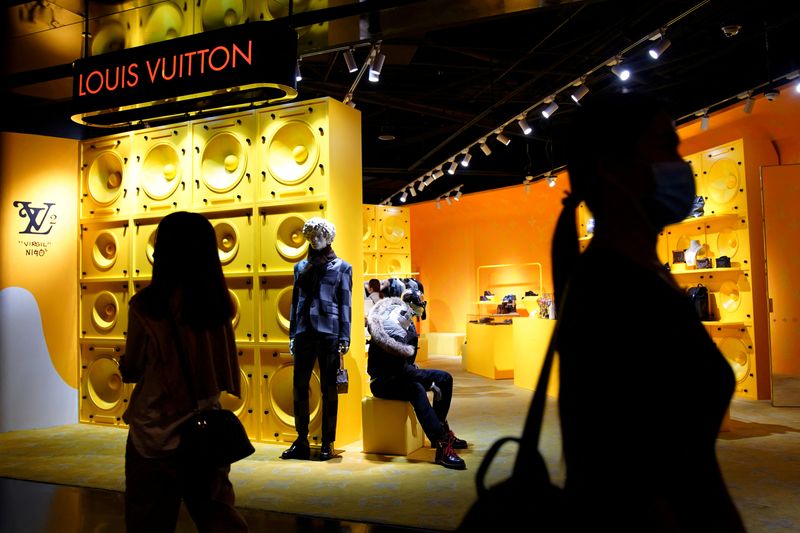Analysis-Investors’ route to post-COVID China is via Europe
2023.05.10 02:20

© Reuters. FILE PHOTO: Customers wearing face masks following the COVID-19 outbreak walk past a store of French luxury brand Louis Vuitton inside a shopping mall in Beijing, China September 19, 2020. REUTERS/Tingshu Wang/File Photo/File Photo
2/3
By Alun John and Ankur Banerjee
LONDON/SINGAPORE (Reuters) – Investors are getting more bang for their buck this year by buying European companies with a focus on China than buying Chinese companies themselves, a sign of the unevenness of China’s pandemic recovery and geopolitical concerns.
Late last year, China dismantled its strict zero-COVID policy, helping its economy rebound by a faster-than-expected 4.5% in the first quarter of 2023.
The recovery has been patchy, however. Pent-up consumer demand has boosted the services sector, but manufacturing has lagged. Property and tech have been bruised by regulatory crack-downs, indebted local governments have little spare cash to spend, and youth unemployment is well above the national average.
“Certainly people are spending, the consumption side is real. But there is not much more beyond that,” Geoff Yu, senior EMEA market strategist at BNY Mellon (NYSE:), said.
Investors must now hunt for more nuanced ways to trade China’s post-COVID economy.
“We are looking into ways to express this (China recovery) theme in our portfolio rather than just say ‘let’s go long China equity’. That trade is too simple, and there are a lot of uncertainties,” said Wang Taosha, Fidelity portfolio manager.
“The old playbook, where Chinese recoveries were associated with a rebound in construction and housing, is not necessarily the case this time, and obviously there is the geopolitical overhang and the previous rounds of domestic regulatory reforms that were applied to the tech and education sector.”
Wang is positive on China, but her preferred route is via the luxury sector, mainly due to the savings built up during the pandemic, particularly by the wealthy, and pent-up demand for travel.
Many potential beneficiaries are listed in Europe, where nearly 2% of euro zone GDP is exposed to China, compared with just over 0.5% for the U.S., according to Barclays (LON:).
Europe’s index is up around 10% year-to-date, outperforming most other major indices. A milder winter that helped cut energy costs has also helped drive it towards 14-month highs.
China’s onshore blue-chip index is up 5% this year. But a “Shadow China” basket, calculated by Jefferies, which includes European companies that derive over 10% of their revenues from China, has risen 33% since the start of November – roughly when China began reopening – outperforming MSCI’s index of developed European markets by 5.3%.
One beneficiary is LVMH, the first European company to top $500 billion in market value, with management flagging China’s reopening as a major driver of both its recent growth and expansion plans.
“Given the higher risk premium of China stocks, the demand for ‘shadowing’ China will continue to be strong,” Jefferies said.
Shadow China starting to outperform MSCI China,
GEOPOLITICS AND BARGAIN HUNTING
“One reason why people go for indirect exposure to China, so through the European market, is to manage the geopolitical risk,” said Emmanuel Cau, Barclays head of European equity strategy.
“If you go straight to China, you have more risk than going indirectly (through Europe), where you have liquidity and can be in and out of the market as quickly as you want.”
China’s increased focus on data security, which restricted overseas customers’ access to business data, has included raids on consulting and due diligence firms’ offices and has only added to those concerns.
The relative cheapness of European stocks, at least at the start of this year, has also been important.
“LVMH, obviously, had very good results but it’s trading on a 33 times multiple. The mainland retailers in China, which don’t own the brands, are trading on 70 times multiple,” said James Cook, head of investment specialists at Federated Hermes (NYSE:).
“We own (Swiss watch company) Swatch. That is a sort of an innovative way of playing the resurgence in luxury consumption in China, but it is also a discounted way of playing that.”
Chinese blue chips trade at a price-to-earnings ratio of nearly 30, compared to just 13.5 for the STOXX 600, according to Refinitiv data.
But it’s not a simple case of “buy Europe”. Luxury stocks – less vulnerable to sanctions – have performed well, but geopolitical worries have bruised tech firms, and manufacturing difficulties have hurt commodity stocks.
Even some consumer goods firms have faced headwinds. Adidas (OTC:)’ first quarter results last week showed the company struggling to maintain market share, though its management said the Chinese market is improving.
“You had to buy the right China exposure,” said Barclays’ Cau. “What is doing extremely well this year is luxury; if you’d bought European miners hoping that China would stimulate, you’d have got it wrong.”
Lap of luxury,








